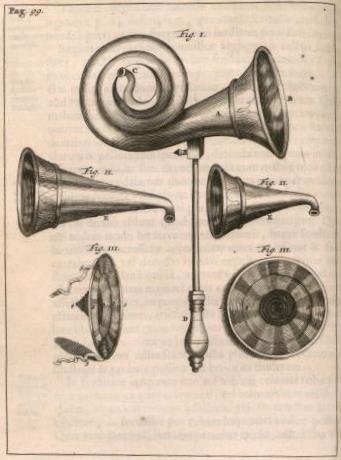
We might take it as a given that our hearing aids are barely visible, can be controlled with our smartphones, and can differentiate between speech and background sound. What we might not realize, however, is that those capabilities are the results of 400 years of research, design, and enhancement.
Even as early as 5 years ago, hearing aids could not yield the clarity of sound produced today. To see why, let’s track the history of hearing aids—starting today and moving in reverse—to see how hearing aids would have treated your hearing loss in four different years: 2016, 1985, 1940, and 1650.
2016 – Contemporary Digital Hearing Aids
It’s 2016 and you’re searching to treat your hearing loss. You launch a web browser, search for a local hearing care professional, fill out a brief form, and schedule an appointment.
At your hearing exam, your hearing is screened using state-of-the-art computer technology that accurately assesses your hearing. Then, with the assistance of your hearing specialist, you choose a hearing aid that suits your needs from a vast range of models.
Then, your hearing consultant programs your new hearing aids to intensify only the sounds and frequencies you have difficulty hearing, producing crystal clear sound without distortion.
If you told someone in the 1980’s that this would be the process, they wouldn’t have believed it was possible.
So what did make it possible? In short, digital technology.
For the majority of their history, there was no way for hearing aids to differentiate between various sound frequencies. Hearing aids would amplify all inbound sound, including background noise, producing distorted sound.
The digital revolution solved that challenge. With digital technology, all information can be transformed, saved, and manipulated as permutations of 0’s and 1’s. Digital technology allowed hearing aids to convert sound frequencies into digital information, which could then be categorized based on which sounds should be amplified (speech) and which should be restrained (background noise).
The first all-digital hearing aid was produced in 1995, and since then the technology has improved dramatically, ultimately to incorporate wireless functionality.
1985 – Transistor Hearing Aids
Now it’s 1985 and you’re looking to treat your hearing loss. You can forget about searching for a local hearing care provider on the internet because the first commercial internet service provider won’t be founded until 1989.
You’d have to use the phone book, rely on referrals, or drive around the neighborhood to find a hearing care practice.
After booking a consultation and having your hearing analyzed, your options for hearing aids are very limited. Without the microprocessor and digital technology, hearing aids were built with a series of transistors. This adds size and higher power requirements, leading to bigger batteries and larger hearing aids.
Also, without the advantage of digital technology, the hearing aid can’t differentiate between various frequencies of sound. Hearing aids receive incoming sound and the transistors function as basic amplifiers, amplifying all sound. So if you’re in a noisy area, speech recognition will be nearly impossible.
1940 – Vacuum Tube Hearing Aids
It’s 1940 and you’re contemplating purchasing a hearing aid. Transistors haven’t been applied to hearing aids yet, so your options are limited to vacuum tube hearing aids.
Vacuum tubes consume more power than transistors, so the hearing aids call for larger batteries, making the hearing aids large, heavy, and awkward.
And once again, without digital technology, the hearing aids can only act as straightforward amplification systems, making all incoming sound louder. The hearing aids cannot enrich speech and cannot filter out background noise.
1650 – Ear Trumpets
Let’s travel all the way back to 1650. There’s no digital technology, no transistors, and no vacuum tubes. As a result, there is no way to convert sound into electrical currents that can be amplified.
With electrical amplification out of the question, your only choice is mechanical amplification by focusing and compressing sound into the ear, such as what takes place when you cup your hands around your ears.
By 1650, products were developed that focused incoming sound into the ears, and these devices were named ear trumpets. They were large gadgets with a conical end that collected sound and a narrow end that focused the sound into the ear.
This would be the only technology offered to individuals with hearing loss for the following 250 plus years.
Let’s return to 2016. Throughout more than 400 years of history, hearing aids have develop from mechanical amplification devices to electrical amplification devices, from vacuum-tube-based to digital-based. They’ve come to be considerably more compact, lighter, and more effective and affordable.
They’ve also become better at differentiating between various types of sound, and in amplifying only specified kinds of sound (such as amplifying speech while suppressing background noise).
Every generation of hearing aid has made a significant improvement over the previous generation. The question is, what’s the next great milestone in the history of hearing aids?
Will we eventually be able to enhance natural human hearing, rather than merely restore it?
